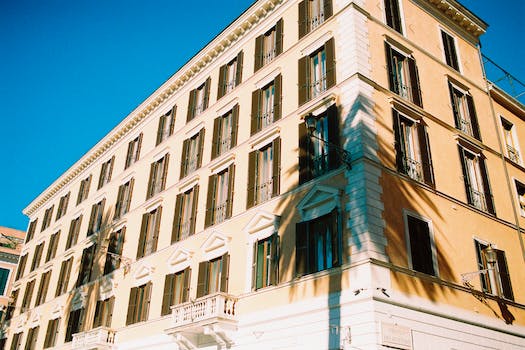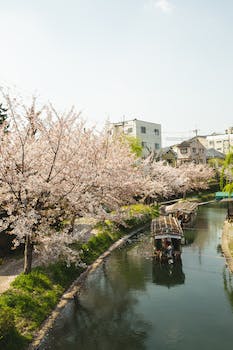

-
Table of Contents
Uncover the Literary Landscapes that Ignite Genius.
Introduction
Literature has the power to transport us to different worlds, evoke emotions, and challenge our perspectives. Behind every great literary work lies the inspiration drawn from the places that shaped the minds of literary geniuses. Exploring these inspiring places not only offers a glimpse into the lives of these renowned authors but also provides a deeper understanding of the creative process and the profound impact of environment on their work. From the bustling streets of Paris that influenced Hemingway's "A Moveable Feast" to the serene Lake District that inspired Wordsworth's poetry, these locations hold the key to unraveling the mysteries behind some of the greatest literary masterpieces in history. Join us on a journey as we delve into the captivating landscapes and vibrant cities that ignited the imaginations of literary geniuses throughout the ages.
The Enchanting Landscapes that Inspired Famous Authors
The world of literature is filled with countless masterpieces that have captivated readers for generations. Behind these timeless works are the brilliant minds of famous authors who drew inspiration from the enchanting landscapes that surrounded them. From rolling hills to rugged coastlines, these places have left an indelible mark on the literary world.
One such place is the Lake District in England, which served as a muse for the renowned poet William Wordsworth. Nestled amidst picturesque mountains and serene lakes, this region provided Wordsworth with the perfect backdrop for his romantic poetry. The beauty of the landscape, with its vibrant colors and tranquil atmosphere, seeped into his verses, evoking a sense of awe and wonder in readers.
Moving across the Atlantic, we find ourselves in the rugged wilderness of the American West, which inspired the likes of Mark Twain and Jack London. Twain, known for his iconic novel "The Adventures of Huckleberry Finn," drew inspiration from the mighty Mississippi River. Its meandering course and ever-changing currents mirrored the journey of his characters, adding depth and authenticity to his storytelling.
London, on the other hand, found solace and inspiration in the vast landscapes of Alaska and the Yukon. His experiences as a gold prospector during the Klondike Gold Rush shaped his writing, infusing it with a raw and untamed energy. The harsh winters, frozen rivers, and towering mountains became characters in their own right, reflecting the struggles and triumphs of his protagonists.
Heading south to the sun-drenched shores of the French Riviera, we encounter the idyllic landscapes that inspired F. Scott Fitzgerald. The glamorous and decadent lifestyle of the 1920s elite found its home in the vibrant cities of Nice and Cannes. The azure waters of the Mediterranean and the opulent villas that dotted the coastline provided the backdrop for his masterpiece, "The Great Gatsby." The juxtaposition of wealth and despair, of dreams and disillusionment, was brought to life through the vivid descriptions of this enchanting region.
Venturing further east, we find ourselves in the mystical land of India, which left an indelible mark on the works of Rudyard Kipling. The lush jungles of Madhya Pradesh and the majestic Himalayas served as the backdrop for his iconic novel, "The Jungle Book." The untamed wilderness and exotic wildlife became the canvas on which Kipling painted his tales of adventure and self-discovery.
Finally, we arrive in the hauntingly beautiful landscapes of Ireland, which inspired the likes of James Joyce and W.B. Yeats. The rugged cliffs of the Atlantic coast and the rolling green hills of the countryside provided the setting for their literary masterpieces. Joyce's "Ulysses" captured the essence of Dublin, with its bustling streets and vibrant culture, while Yeats' poetry drew inspiration from the mystical landscapes of Sligo and the ancient legends that permeated the land.
In conclusion, the landscapes that shaped literary geniuses are as diverse as the authors themselves. From the serene lakes of England to the untamed wilderness of Alaska, these places have left an indelible mark on the world of literature. Through their vivid descriptions and evocative storytelling, these authors have transported readers to enchanting worlds, forever immortalizing the landscapes that inspired them.
Uncovering the Hidden Gems: Literary Destinations Off the Beaten Path

Exploring the Inspiring Places that Shaped Literary Geniuses
Uncovering the Hidden Gems: Literary Destinations Off the Beaten Path
Literature has the power to transport us to different worlds, to ignite our imagination, and to inspire us in ways we never thought possible. Behind every great literary work lies a story, and often, the places that shaped the minds of these literary geniuses are just as fascinating as the works they produced. While many famous literary destinations like Paris, London, and New York are well-known, there are hidden gems off the beaten path that offer a unique glimpse into the lives and inspirations of these great writers.
One such hidden gem is the Brontë Parsonage Museum in Haworth, England. This unassuming village was home to the Brontë sisters, Charlotte, Emily, and Anne, who penned some of the most beloved works in English literature. The museum, located in the former home of the Brontë family, allows visitors to step back in time and experience the very rooms where these literary giants lived and wrote. From Charlotte's tiny writing desk to Emily's hauntingly beautiful poetry, the museum offers a rare opportunity to connect with the minds behind the words.
Another literary destination that should not be missed is the Mark Twain House and Museum in Hartford, Connecticut. This stunning Victorian mansion was once the home of Samuel Clemens, better known by his pen name, Mark Twain. Twain, considered one of America's greatest writers, wrote many of his most famous works, including "The Adventures of Tom Sawyer" and "Adventures of Huckleberry Finn," while living in this house. Visitors can explore the beautifully preserved rooms, including Twain's study, where he penned his iconic tales. The museum also offers insights into Twain's personal life, showcasing his love for travel and his passion for social justice.
For those seeking a literary destination with a touch of mystery, the Edgar Allan Poe House and Museum in Baltimore, Maryland, is a must-visit. This modest brick house was once the residence of the enigmatic poet and writer, Edgar Allan Poe. Known for his dark and macabre tales, Poe's former home offers a glimpse into the mind of a literary genius. Visitors can explore the rooms where Poe lived and wrote, including the basement where he is said to have found inspiration for his chilling stories. The museum also houses a collection of Poe's personal belongings, providing a deeper understanding of the man behind the haunting tales.
Heading across the Atlantic, we find ourselves in Dublin, Ireland, home to the James Joyce Centre. James Joyce, one of the most influential writers of the 20th century, was born and raised in Dublin, and the city played a significant role in shaping his literary style. The James Joyce Centre offers a comprehensive look into Joyce's life and works, with exhibits showcasing his manuscripts, letters, and personal belongings. Visitors can also take guided walking tours through the streets of Dublin, following in the footsteps of Joyce's characters and experiencing the city that inspired his groundbreaking novel, "Ulysses."
These hidden gems off the beaten path offer a unique opportunity to delve into the lives and inspirations of literary geniuses. From the Brontë sisters' secluded home in Haworth to Mark Twain's grand mansion in Hartford, each destination provides a window into the minds of these great writers. Whether you're a literature enthusiast or simply seeking a new adventure, these literary destinations are sure to inspire and captivate, reminding us of the power of words and the places that shaped them.
From Hemingway to Austen: Exploring the Homes of Literary Icons
Exploring the Inspiring Places that Shaped Literary Geniuses
From Hemingway to Austen: Exploring the Homes of Literary Icons
Literature has the power to transport us to different worlds, to make us feel and think deeply, and to inspire us in countless ways. Behind every great literary work lies the mind of a genius, and often, the physical spaces that shaped their creativity. Exploring the homes of these literary icons allows us to gain a deeper understanding of their lives and the environments that nurtured their brilliance.
One such literary genius is Ernest Hemingway, whose home in Key West, Florida, is a testament to his adventurous spirit and love for the sea. The house, now a museum, is filled with artifacts and memorabilia that offer a glimpse into Hemingway's life. As you walk through the rooms, you can almost feel his presence, surrounded by the books he loved and the typewriter he used to craft his masterpieces. The lush gardens outside, with their tropical plants and wandering cats, evoke the same sense of tranquility that Hemingway must have felt as he sought inspiration for his writing.
Moving across the Atlantic, we find ourselves in the picturesque village of Chawton, England, where Jane Austen spent the last years of her life. Austen's home, now the Jane Austen's House Museum, is a place of pilgrimage for fans of her timeless novels. Stepping into the house, you are transported back to the early 19th century, surrounded by the same furniture and objects that Austen herself would have used. The quaint garden, with its blooming flowers and serene atmosphere, is said to have provided Austen with the peace and solitude she needed to create her beloved characters and stories.
In the heart of Dublin, Ireland, lies another literary gem: the James Joyce Centre. This Georgian townhouse was once home to the renowned Irish writer and is now a museum dedicated to his life and works. As you wander through the rooms, you can almost hear the echoes of Joyce's words, as if his spirit still lingers within the walls. The museum offers a fascinating insight into Joyce's creative process, with displays of his manuscripts, letters, and personal belongings. It is a place where literature comes alive, and where visitors can connect with the mind of a literary genius.
Venturing further into the United Kingdom, we find ourselves in the Lake District, a region that inspired countless poets and writers, including William Wordsworth. Dove Cottage, Wordsworth's former home, is now a museum that allows visitors to step into the world of this Romantic poet. The cottage, nestled among the rolling hills and picturesque landscapes, is a place of tranquility and natural beauty. It is easy to see how the surrounding nature influenced Wordsworth's poetry, as he found solace and inspiration in the breathtaking scenery that surrounded him.
These are just a few examples of the many inspiring places that shaped literary geniuses. Exploring these homes and museums allows us to connect with the minds behind the words, to understand the environments that nurtured their creativity, and to gain a deeper appreciation for their works. Whether it is the tropical paradise of Key West, the quaint village of Chawton, the bustling city of Dublin, or the serene landscapes of the Lake District, each place offers a unique insight into the lives and minds of these literary icons. So, next time you find yourself in the vicinity of one of these inspiring places, take a moment to step into the world of a literary genius and let their words guide you on a journey of imagination and inspiration.
Q&A
1. What are some inspiring places that shaped literary geniuses?
Some inspiring places that shaped literary geniuses include Paris for Ernest Hemingway, Lake District for William Wordsworth, and Edinburgh for J.K. Rowling.
2. How did these places influence the literary geniuses?
These places provided literary geniuses with unique experiences, cultural inspiration, and a sense of belonging, which greatly influenced their writing styles and themes.
3. Can you provide an example of a literary genius and the place that shaped them?
One example is Dublin, which greatly influenced James Joyce's writing. The city's streets, people, and history served as a rich source of inspiration for his works, particularly in his masterpiece "Ulysses."
Conclusion
In conclusion, exploring the inspiring places that shaped literary geniuses provides valuable insights into the creative process and the impact of environment on artistic expression. These places serve as a source of inspiration, allowing writers to connect with their surroundings and draw from the rich history and culture that surrounds them. By visiting these locations, readers and aspiring writers can gain a deeper understanding of the works produced by these literary geniuses and appreciate the profound influence of their surroundings on their creative output.












